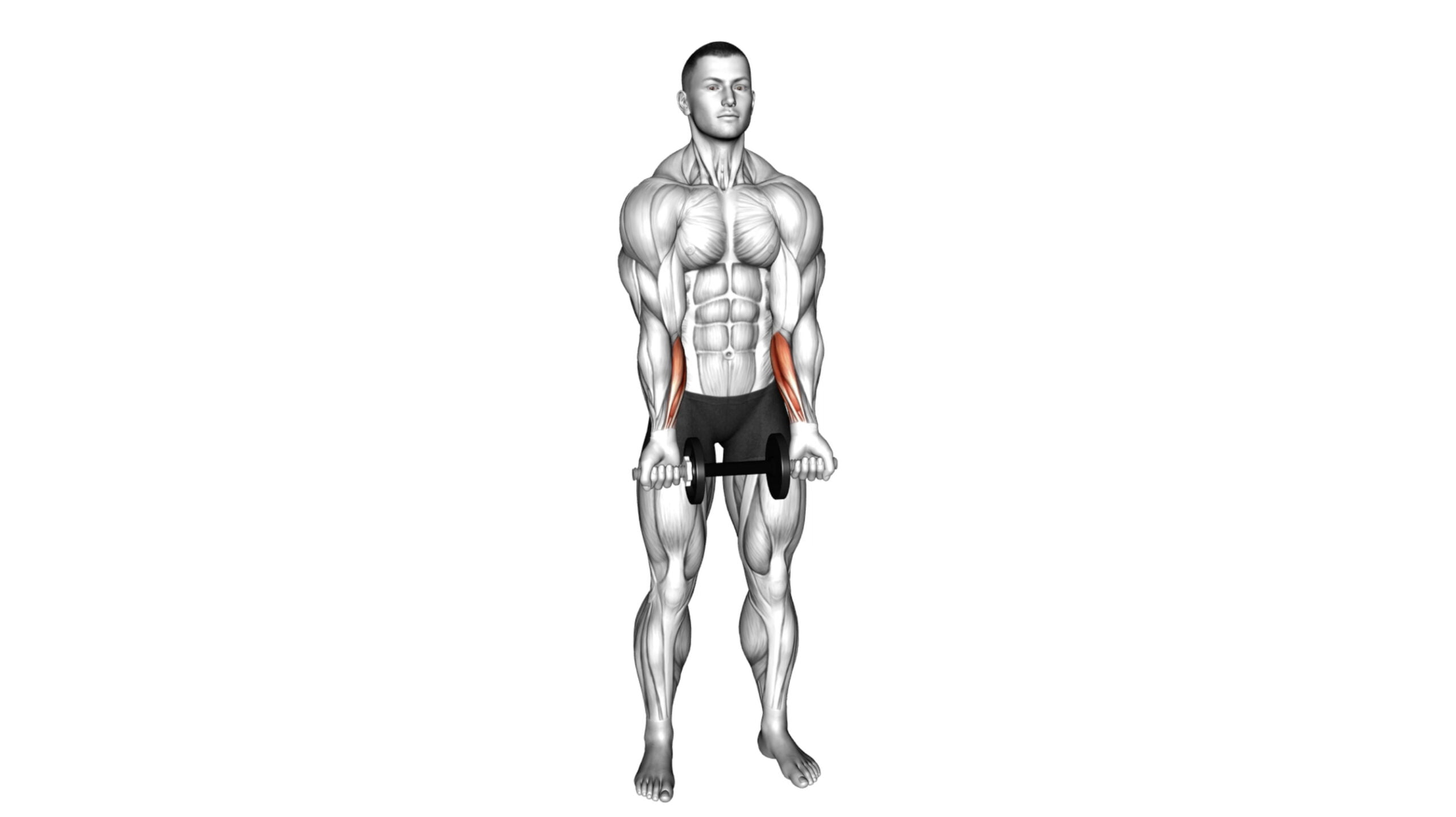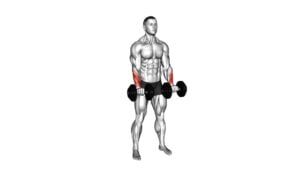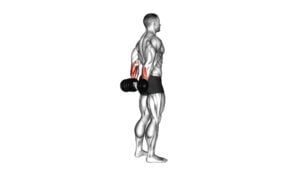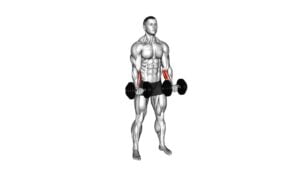Dumbbell Standing Wrist Curl – Video Exercise Guide & Tips

Are you looking to strengthen your wrists and forearms? Look no further than the dumbbell standing wrist curl!
Watch This Exercise Video
In this video exercise guide, we’ll show you the proper form and technique for this effective workout.
You’ll also discover variations to challenge yourself and learn common mistakes to avoid.
Maximize your results with our expert tips.
Get ready to pump up those wrists and achieve stronger, more resilient hands.
Let’s get started!
Key Takeaways
- Dumbbell standing wrist curls can improve wrist strength and enhance power and control in athletic performance.
- They also enhance grip strength and reduce the risk of wrist injuries.
- Dumbbell standing wrist curls can enhance upper body strength and stability.
- Variations like reverse grip wrist curls and single arm wrist curls can target different muscles in the forearm and promote muscle growth and overall strength.
Benefits of Dumbbell Standing Wrist Curl
You can experience several benefits by incorporating the dumbbell standing wrist curl into your workout routine. One important benefit is the improvement in wrist strength, which plays a crucial role in athletic performance. Having strong wrists can enhance your ability to generate power and control in activities such as weightlifting, golf, tennis, and even everyday tasks like carrying heavy objects.
Incorporating wrist curls into a full body workout routine is a smart move. It not only targets the muscles in your forearms but also engages the muscles in your hands and fingers. This exercise can help improve grip strength, which is essential for activities like rock climbing or holding onto a baseball bat. Stronger wrists and hands can also reduce the risk of injuries such as sprains or strains.
By adding dumbbell standing wrist curls to your workout routine, you can achieve overall upper body strength and stability. This exercise specifically targets the flexor muscles in the wrists, which are responsible for movements like wrist flexion and extension. Strengthening these muscles can lead to better performance in sports that require wrist movements, such as boxing or martial arts.
Proper Form and Technique
To perform the dumbbell standing wrist curl with proper form and technique, ensure that you maintain a firm grip on the dumbbells and keep your elbows stationary throughout the exercise. This exercise is great for wrist strengthening and can help improve your grip strength.
When performing the dumbbell standing wrist curl, it’s important to avoid common errors that may compromise your form and reduce the effectiveness of the exercise.
One common error is using too much weight. Start with a lighter weight and gradually increase as your strength improves.
Another error is allowing your wrists to bend backward or forward during the movement. Keep your wrists in a neutral position throughout the exercise.
It’s also important to avoid using momentum to lift the dumbbells. Focus on using your wrist muscles to control the movement.
Variations to Challenge Yourself
To further challenge yourself with the dumbbell standing wrist curl, try incorporating variations that target different muscles in the forearm. Here are three advanced wrist curl exercises that you can add to your workout routine:
- Reverse Grip Wrist Curl: Instead of holding the dumbbell with an overhand grip, turn your palms facing downwards. This variation primarily targets the extensor muscles in your forearms, providing a comprehensive workout for both the flexor and extensor muscles.
- Single Arm Wrist Curl: Perform the standing wrist curl exercise with only one arm at a time. This variation allows you to focus on each forearm individually, ensuring balanced strength development and enhancing stability.
- Plate Pinch Wrist Curl: Instead of using dumbbells, hold two weight plates together, sandwiched between your fingers and thumb. By pinching the plates, you engage your grip strength more intensely, making this variation ideal for improving forearm and wrist strength.
Incorporating these dumbbell standing wrist curl modifications into your routine will challenge your forearms in new ways, promoting muscle growth and overall strength. Remember to start with lighter weights and gradually increase the resistance as you become more comfortable with each variation.
Common Mistakes to Avoid
Avoiding these common mistakes is crucial when performing the dumbbell standing wrist curl exercise. By staying aware of these errors, you can minimize the risk of injuries and maximize the effectiveness of your workout.
One common mistake to avoid is using weights that are too heavy. It’s important to choose a weight that challenges your muscles without compromising your form. Starting with lighter weights and gradually increasing as you build strength is recommended.
Another mistake is allowing your wrists to bend or move during the exercise. To prevent this, make sure to keep your wrists straight and stable throughout the movement.
Additionally, avoid using momentum to lift the weights. The focus should be on controlled, deliberate movements to target the wrist muscles effectively.
Lastly, don’t forget to warm up before performing the exercise and cool down afterwards. Warming up helps to prepare your muscles for the workout and reduces the risk of injuries. Cooling down allows for proper recovery and helps prevent muscle soreness.
Tips for Maximizing Results
To optimize your results, focus on implementing these key strategies into your dumbbell standing wrist curl routine:
- Gradually increase intensity levels for beginners:
If you’re new to wrist curls, start with lighter weights and gradually increase the resistance as your strength improves. This will help prevent injury and allow your muscles to adapt and grow over time.
- Incorporate wrist curls into a full body workout:
While wrist curls primarily target the muscles in your forearms, you can maximize your results by incorporating them into a full body workout routine. By combining wrist curls with exercises that target other muscle groups, such as squats, lunges, and bench presses, you’ll engage more muscles and burn more calories, leading to overall better results.
- Focus on proper form and technique:
It’s important to maintain proper form and technique during wrist curls to maximize your results. Keep your back straight, shoulders relaxed, and wrists aligned with your forearms. Avoid using momentum or swinging the weights, as this can take the focus away from your forearms and reduce the effectiveness of the exercise.
Frequently Asked Questions
How Many Sets and Reps Should I Do for the Dumbbell Standing Wrist Curl Exercise?
To determine the number of sets and reps for the dumbbell standing wrist curl exercise, consider factors such as your fitness level and goals. Generally, it’s recommended to start with 2-3 sets of 8-12 reps.
This helps to build strength and endurance in your wrists and forearms. However, you can also vary the sets and reps to challenge yourself and prevent plateauing.
Consulting with a fitness professional can provide personalized guidance for your specific needs.
Can I Perform the Dumbbell Standing Wrist Curl Exercise Using a Resistance Band Instead of Dumbbells?
Yes, you can perform the dumbbell standing wrist curl exercise using a resistance band instead of dumbbells.
Using resistance bands for wrist curls offers several benefits. They provide variable resistance throughout the movement, allowing for a more challenging workout. Resistance bands also target the muscles in your wrists and forearms, helping to improve grip strength and overall wrist stability.
Is It Necessary to Warm up Before Performing the Dumbbell Standing Wrist Curl Exercise?
Before performing the dumbbell standing wrist curl exercise, it’s important to warm up your wrists and forearms. Warming up helps increase blood flow to the muscles, reducing the risk of injury. It also prepares your joints for the exercise.
Common mistakes to avoid during this exercise include using too heavy weights and cheating by using momentum. By warming up and using proper form, you can maximize the benefits and minimize the risk of injury.
Can I Do the Dumbbell Standing Wrist Curl Exercise if I Have Wrist Pain or Injury?
If you’re experiencing wrist pain or injury, it’s important to modify the dumbbell standing wrist curl exercise. Instead of using dumbbells, you can try using resistance bands or a wrist roller to reduce strain on the wrists.
Another alternative is to perform exercises that focus on strengthening the forearms and grip, such as wrist extensions or farmer’s walks.
Always listen to your body and consult with a healthcare professional if you’re unsure about any modifications.
What Muscles Are Specifically Targeted During the Dumbbell Standing Wrist Curl Exercise?
During the dumbbell standing wrist curl exercise, several muscles are specifically targeted.
The primary muscle worked is the flexor digitorum profundus, which is responsible for flexing the fingers at the wrist joint.
Additionally, the flexor carpi radialis and flexor carpi ulnaris muscles are also engaged, as they assist in wrist flexion.
Variations of this exercise can include using different types of equipment or changing the grip position to target the muscles from different angles.
Conclusion
In conclusion, the dumbbell standing wrist curl is an effective exercise for strengthening the wrists and forearms. By following the proper form and technique, variations can be added to increase the challenge and maximize results.
It’s important to avoid common mistakes and remember to always prioritize safety. Incorporating this exercise into your workout routine can lead to improved wrist strength and overall fitness.

Author
Years ago, the spark of my life’s passion ignited in my mind the moment I stepped into the local gym for the first time. The inaugural bead of perspiration, the initial endeavor, the very first surge of endorphins, and a sense of pride that washed over me post-workout marked the beginning of my deep-seated interest in strength sports, fitness, and sports nutrition. This very curiosity blossomed rapidly into a profound fascination, propelling me to earn a Master’s degree in Physical Education from the Academy of Physical Education in Krakow, followed by a Sports Manager diploma from the Jagiellonian University. My journey of growth led me to gain more specialized qualifications, such as being a certified personal trainer with a focus on sports dietetics, a lifeguard, and an instructor for wellness and corrective gymnastics. Theoretical knowledge paired seamlessly with practical experience, reinforcing my belief that the transformation of individuals under my guidance was also a reflection of my personal growth. This belief holds true even today. Each day, I strive to push the boundaries and explore new realms. These realms gently elevate me to greater heights. The unique combination of passion for my field and the continuous quest for growth fuels my drive to break new ground.







